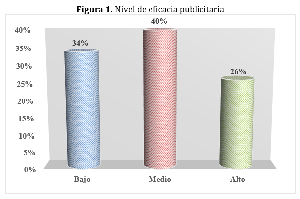Advertising effectiveness and loyalty in clients of a Peruvian initial educational institution
DOI:
https://doi.org/10.51252/race.v1i2.367Keywords:
traditional advertising, virtual advertising, satisfaction, customer retentionAbstract
Customer loyalty is a critical factor for the sustainability of institutions that provide educational services. It is influenced by the quality of service, care, trust, and lately, by advertising and marketing. This research proposes to determine the relationship between the advertising effectiveness of an initial educational institution with customer loyalty. It was based on a basic correlational and cross-sectional study. 50 parents were surveyed during 2018. The questionnaires were validated by experts and made reliable; They had a Likert-type response scale. To find the relationship between the variables, Pearson's Chisquare coefficient was applied. The results show a regular level of advertising effectiveness (40%), as well as customer loyalty (48%); They also reveal the existence of a significant relationship (p<0.05) between advertising effectiveness and customer loyalty (X2C > X2T) at 95% confidence. It is concluded that the inadequate management of advertising strategies affects customer loyalty, and in parallel, in the positioning of educational services.
Downloads
References
Abadi, R., Nursyamsi, I., & Munizu, M. (2018). Effect of Customer Value and Experiential Marketing to Customer Loyalty with Customer Satisfaction as Intervening Variable: Case Study on Go-Jek Makassar Consumers. Proceedings of the 1st Unimed International Conference on Economics Education and Social Science, 767-774. https://doi.org/10.5220/0009505107670774
Aksu, H., Babun, L., Conti, M., Tolomei, G., & Uluagac, A. S. (2018). Advertising in the IoT Era: Vision and Challenges. IEEE Communications Magazine, 56(11), 138-144. https://doi.org/10.1109/MCOM.2017.1700871
Beltyukova, O. V., Erkibaeva, G. G., Zharkova, A. A., Pikalov, Y. V., Klyuchnikova, A. N., Mosienko, L. V., & Vershinin, V. P. (2020). Modern higher education competitiveness: commercial strategies and administrative policy. EurAsian Journal of BioSciences, 14(2), 3485-3490.
Binnawas, M. S. H., Khalifa, G. S. A., & Bhaumick, A. (2020). Antecedents of Student’s Behavioral Intentions in Higher Education Institutions. International Journal of Psychosocial Rehabilitation, 24(03), 1949-1962. https://doi.org/10.37200/IJPR/V24I3/PR200942
Budianto, A., Bastaman, I. D., & Fauziyah, A. (2019). Modern Market Customer Loyalty: Advertising Promotion Strategies. Jurnal Manajemen, 10(2), 111. https://doi.org/10.32832/jm-uika.v10i2.2416
Chairunnisa, C. (2018). The Effect of Brand Image And Quality Of Educational Services On Customer Satisfaction. Jurnal Manajemen, 22(3), 325. https://doi.org/10.24912/jm.v22i3.425
Dixson, A. D., & Rousseau Anderson, C. (2018). Where are We? Critical Race Theory in Education 20 Years Later. Peabody Journal of Education, 93(1), 121-131. https://doi.org/10.1080/0161956X.2017.1403194
Gholizadeh, B., Talebpour, M., Kashtidar, M., & Abdolmaleki, H. (2018). Mouth advertising, an effective tool for loyalty of sport customers, case study: women’s health clubs in Mashhad. International Journal of Leisure and Tourism Marketing, 6(1), 51-64. https://doi.org/10.1504/IJLTM.2018.089224
Haji, R., & Stock, W. G. (2021). User settings for advertising optimization on Facebook: Active customer participation or settings blindness? Telematics and Informatics, 59, 101548. https://doi.org/10.1016/j.tele.2020.101548
Hernández Sampieri, R., Fernández Collado, C., & Baptista Lucio, P. (2014). Metodología de la investigación (6ta ed.). McGraw-Hill Education.
Hwang, Y.-S., & Choi, Y. K. (2019). Higher education service quality and student satisfaction, institutional image, and behavioral intention. Social Behavior and Personality: an international journal, 47(2), 1-12. https://doi.org/10.2224/sbp.7622
Lu, C.-C., Wu, I.-L., & Hsiao, W.-H. (2019). Developing customer product loyalty through mobile advertising: Affective and cognitive perspectives. International Journal of Information Management, 47, 101-111. https://doi.org/10.1016/j.ijinfomgt.2018.12.020
Manggarani, C. A. (2018). El papel del compromiso con el cliente en la lealtad del cliente: un estudio en una institución privada de educación superior. Hasanuddin Economics and Business Review, 2(1), 71. https://doi.org/10.26487/hebr.v2i1.1483
Muñoz, R., & Navarro, E. (2015). Gestión comercial de productos y servicios financieros y los canales complementarios (1ra ed.). Parainfo, S.A.
Orozco-Gonzales, I., Villa, L., Rodriguez-Miranda, G., & Sanchez-Serafin, J. (2015). Estrategias de promoción “on line”, “ off line” para pequeñas empresas editoriales. Revista de Aplicación Científica y Técnica, 1(2), 102-112.
Sauza, B., & Pérez, S. (2014). Rumbo a la conformación de redes de colaboración en estudios empresarial. TESCo, ITESA, UAEH, UATx, UTSH: México.
Sebastián-Morillas, A., Muñoz-Sastre, D., & Núñez-Cansado, M. (2020). Importancia de la estrategia de comunicación y su relación con el insight para conseguir la eficacia publicitaria: el caso de España. Cuadernos.info, 46, 249-280. https://doi.org/10.7764/cdi.46.1786
Vetrova, E. A., Kabanova, E. E., Medvedeva, N. V., & Jukova, E. E. (2019). Management of Educational Services Promotion in the Field of Higher Education (the Example of «Russian State Social University»). European Journal of Contemporary Education, 8(2), 370-377. https://doi.org/10.13187/ejced.2019.2.370

Published
How to Cite
Issue
Section
License
Copyright (c) 2022 Carlos García-Villacorta, Martha Reátegui-Reátegui, Seidy Vela-Reátegui, Pierre Vidaurre-Rojas

This work is licensed under a Creative Commons Attribution 4.0 International License.




